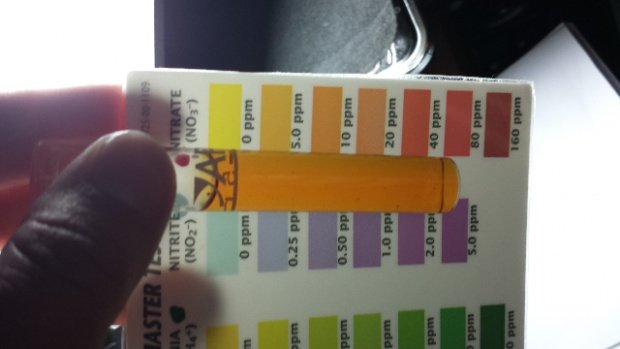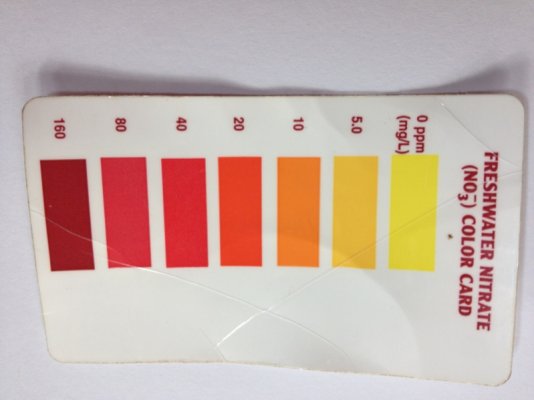You are using an out of date browser. It may not display this or other websites correctly.
You should upgrade or use an alternative browser.
You should upgrade or use an alternative browser.
Hmmm...
- Thread starter phin9009
- Start date
The friendliest place on the web for anyone with an interest in aquariums or fish keeping!
If you have answers, please help by responding to the unanswered posts.
If you have answers, please help by responding to the unanswered posts.
Fishperson
Aquarium Advice Addict
Yeah, looks closer to 10, but somewhere between 10 and 20
phin9009
Aquarium Advice Regular
Ok thanks  I can't really see a difference in the color on the card so testing in the future could be interesting when I'm trying to keep nitrates under 20 (fishless cycling at the moment)
I can't really see a difference in the color on the card so testing in the future could be interesting when I'm trying to keep nitrates under 20 (fishless cycling at the moment)
jlk
Aquarium Advice Addict
Looks between 5 and 10 to me. You should call API and ask for an individual nitrate color chart (they should send one for free). Its different than the master test chart and its easier to read for low numbers (40 or less). The master chart is easier to read for high numbers.
phin9009
Aquarium Advice Regular
Ok I will definitely be calling them for that then! Be nice to be able to tell the difference.
jlk
Aquarium Advice Addict
phin9009
Aquarium Advice Regular
Awesome thank you 
Fishfur
Aquarium Advice Addict
You might also want to read test results in the best light you can get, and always the same light. Daylight is best for distinguishing colours that are similar, but 6500K or similar is pretty close to daylight for this purpose.
If you always read in the same light, you will find it gets a bit easier to figure them out as time goes on. Most of us have at least a bit of trouble distinguishing between some of the colours, especially the ammonia one, but practice does help some.
If you always read in the same light, you will find it gets a bit easier to figure them out as time goes on. Most of us have at least a bit of trouble distinguishing between some of the colours, especially the ammonia one, but practice does help some.
phin9009
Aquarium Advice Regular
I always read my test with a "natural" light lamp. Ammonia tonight are between 0 and 0.25ppm, nitrites are (still) 0, and nitrates are between 20 and 40, closer to the 40 
Fishfur
Aquarium Advice Addict
Is that an API ammonia test ? If so, be aware, it does not distinguish between free ammonnia, the dangerous one, and ammonium, the chemically bound one that is not usually dangerous.
If you have a reading of .25 or less it may not be free ammonia. API shows only the total of all ammonia, regardless of form. If you have nitrites and nitrates and still get that low reading, it's likely ammonium that is the cause.
If you have a reading of .25 or less it may not be free ammonia. API shows only the total of all ammonia, regardless of form. If you have nitrites and nitrates and still get that low reading, it's likely ammonium that is the cause.
phin9009
Aquarium Advice Regular
It is the API test. I didn't know if ammonium was possible since I have a pH of 7.6ish and I'm using 100% RO water dosed with Seachem Replenish to add buffers and replenish the minerals (long story about the RO water)
Fishfur
Aquarium Advice Addict
It's true that if water is alkaline, more ammonium will be converted to ammonia, which can be an issue if you have acidic water and the pH is raised. Then ammonium may be quite suddenly converted to ammonia, causing a spike.
You'll have more Ammonium in acidic water, but it's quite possible to have some in alkaline water too.
One of the reasons I favour the Seachem ammonia test is because it does tell you how much ammonia and how much ammonium you actually have, rather than taking both together in one reading as the API test does.
You'll have more Ammonium in acidic water, but it's quite possible to have some in alkaline water too.
One of the reasons I favour the Seachem ammonia test is because it does tell you how much ammonia and how much ammonium you actually have, rather than taking both together in one reading as the API test does.
phin9009
Aquarium Advice Regular
Ok, I will keep that in mind. I am going to test again tomorrow night to see if it drops to 0 before adding more ammonia for my fishless cycle
Similar threads
- Replies
- 2
- Views
- 543
- Replies
- 7
- Views
- 577
- Replies
- 2
- Views
- 482


